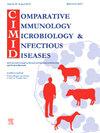Investigation of the epidemiology of calicivirus infection of cats using molecular and virus isolation techniques
IF 2
3区 农林科学
Q4 IMMUNOLOGY
Comparative Immunology Microbiology and Infectious Diseases
Pub Date : 2025-03-10
DOI:10.1016/j.cimid.2025.102335
引用次数: 0
Abstract
Feline calicivirus (FCV) an important and widely detected upper respiratory system agent in cats. Being genetically diverse, FCV can cause different symptoms, such as pneumonia, oral lesions, conjunctivitis, arthritis, and, recently, virulent systemic disease. The present study first determined the presence/prevalence of FCV infection in sampled vaccinated/unvaccinated cats with suspected FCV and/or clinically healthy. Second, it compared PCR and virus isolation (VI) in detecting FCV in these cats. It also aimed to diagnose FCV, and evaluate the advantages/disadvantages of the region and primers used for PCR. Third, it genetically characterized the FCV strains, targeting the VP1 (A-B and E) gene region. A total of 331 diagnostic materials (conjunctival, nasal, oropharyngeal swab samples, and EDTA-containing blood samples) were obtained from 107 cats and checked using PCR and VI. Including both tests, the overall FCV positivity rate was 43.93 % (47/107). The FCV positivity rate was 35.99 % (21/59)/53.33 % (24/45) in vaccinated/unvaccinated and 58.06 % (18/31)/38.16 % (29/76) in clinically infected/clinically healthy cats, respectively. As a result of direct nested RT-PCR, FCV positivity was detected in 23.08 % of oropharyngeal swabs, 15.24 % of nasal swabs and 14.02 % of conjunctival swabs based on diagnostic material. FCV was also detected in 19.63 % (21/107) of the cats after virus isolation. Those samples that were FCV positive for VP1 A-B and VP1 E were subjected to sequence and phylogenetic analysis. Regarding many of the detected viruses were similar to the viruses in Genogroup I, while two viruses (ANK111OSW and ANK113OSW) were phylogenetically similar to both Genogroup I and Genogroup II at the same rate (74.30 %). The findings indicate a, higher overall FCV detection rate than in previous studies in Türkiye. Molecular diagnostic methods are not always sufficient for diagnosing infection due to FCV’s genetic diversity from mutation and, recombination. Hence, including VI techniques in FCV evaluation will help prevent false negative results. Furthermore, testing oropharyngeal, nasal and conjunctival swabs together for FCV is believed to provide more accurate results.
应用分子分离和病毒分离技术研究猫杯状病毒感染的流行病学
猫杯状病毒(FCV)是一种在猫体内广泛检测到的重要上呼吸道病毒。由于遗传多样性,FCV可引起不同的症状,如肺炎、口腔病变、结膜炎、关节炎,以及最近出现的致命性全身性疾病。本研究首先确定了接种疫苗/未接种疫苗的疑似FCV和/或临床健康的猫样本中FCV感染的存在/流行。其次,比较PCR和病毒分离(VI)检测FCV的效果。本研究还旨在诊断FCV,并评估用于PCR的区域和引物的优缺点。第三,以VP1 (A-B和E)基因区域为靶点,对FCV菌株进行遗传表征。从107只猫共获得331份诊断材料(结膜、鼻腔、口咽拭子样本和含edta的血液样本),并采用PCR和VI检测。包括两项检测在内,FCV总阳性率为43.93 %(47/107)。临床感染猫/临床健康猫的FCV阳性率分别为35.99 %(21/59)/53.33 %(24/45)和58.06 %(18/31)/38.16 %(29/76)。直接巢式RT-PCR检测结果显示,23.08 %的口咽拭子、15.24 %的鼻拭子和14.02 %的结膜拭子检出FCV阳性。分离病毒后,19.63 %(21/107)的猫检出FCV。对VP1 A-B和VP1 E阳性的FCV样本进行序列分析和系统发育分析。许多检测到的病毒与基因组I的病毒相似,而两个病毒(ANK111OSW和ANK113OSW)与基因组I和基因组II的系统发育相似率相同(74.30 %)。研究结果表明,与以前的研究相比, rkiye的FCV检出率更高。由于FCV突变和重组的遗传多样性,分子诊断方法并不总是足以诊断感染。因此,在FCV评估中纳入VI技术将有助于防止假阴性结果。此外,同时检测口咽、鼻腔和结膜拭子检测FCV被认为可以提供更准确的结果。
本文章由计算机程序翻译,如有差异,请以英文原文为准。
求助全文
约1分钟内获得全文
求助全文
来源期刊
CiteScore
4.60
自引率
0.00%
发文量
102
审稿时长
40 days
期刊介绍:
Comparative Immunology, Microbiology & Infectious Diseases aims to respond to the concept of "One Medicine" and to provide a venue for scientific exchange. Based on the concept of "Comparative Medicine" interdisciplinary cooperation between specialists in human and animal medicine is of mutual interest and benefit. Therefore, there is need to combine the respective interest of physicians, veterinarians and other health professionals for comparative studies relevant to either human or animal medicine .
The journal is open to subjects of common interest related to the immunology, immunopathology, microbiology, parasitology and epidemiology of human and animal infectious diseases, especially zoonotic infections, and animal models of human infectious diseases. The role of environmental factors in disease emergence is emphasized. CIMID is mainly focusing on applied veterinary and human medicine rather than on fundamental experimental research.

 求助内容:
求助内容: 应助结果提醒方式:
应助结果提醒方式:


